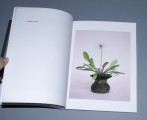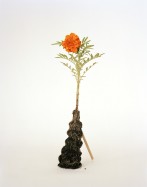

#1
Two springs ago, Diana Scherer tipped a tub of soil out on her balcony and sowed wildflowers. Months later she photographed the resulting bunch of flowers as a classic still life. More than just recording a composition or arrangement, her photos document an extended sculptural and botanical investigation.
I
Process is key in Scherer’s work. With Nurture Studies, the artist presents an archive of flowers she has grown from seed over a six-month period. Rather than letting the flowers grow in open soil, she has forced each plant to develop within the confines of a vase. Only at the end of the process does she remove the plant’s corset, exposing roots that retain their shape as an evocation of the now absent vase.
There is an inherent contradiction in Scherer’s working method. Although she is dedicated to the project and keeps a close eye on whether the roots are developing as desired—checking them carefully and with the utmost precision—her ability to manipulate the plants’ growth is limited. She has to accept the impossibility of total control. This contrast between almost obsessive monitoring and an inability to fundamentally influence events becomes an intense, almost ritual presence in her work. Sherer’s photos are carefully rationed, showing a single moment as the culmination of a long process of growth. She documents the flowers at their peak, just before they begin to shrivel as the plants start to die.
II
Scherer has always been fascinated by flowers. Although not always prominent in the foreground, they have often played a role in her work. Examples are a dead deer lying on a bed of flowers (Anthology, 2008) or women in floral dresses hanging from the branches of trees (Women, 2004). It is only in her most recent series that she has concentrated on the flower as such, transforming her fascination into an obsession. As a fanatical collector, she has amassed an arsenal of material related to the object of her desire: old garden encyclopaedias, botanical guides, porcelain cups with floral motives and pieces of toilet paper embossed with floral designs. This compulsive collecting lays the groundwork for the images she ultimately records with her camera.
The photos Scherer has produced for Nurture Studies recall the illustrations in seventeenth-century botanical encyclopaedias, which presented flowers roots and all. Her work also has strong similarities with 1970s plant books, in which indoor plants were often arranged on a pedestal and set off with fabrics that added a romantic touch to the whole. Although clearly referring to these predecessors, Scherer has no difficulty avoiding the perceived cosiness of the “pot plant”-genre. Her images are bare, unadorned. The careful observer will notice that most of the plants are anything but perfect specimens. Brown edges and broken stems show that mortality is already making its presence felt. The pink aster’s leaves are already dying off and other plants, dandelion and cow parsley for instance, wouldn’t be deemed worthy of a second glance on the side of the road. Scherer treats them all as equals.
III
The floral portraits form a pendant to earlier photo series in which Scherer opted for much rawer imagery, things like young girls lying on the ground with their backs to the camera, collapsed like rag dolls, so that viewers almost automatically think of them as victims (Mädchen, 2002-2007). In Nurture Studies this confrontational imagery has made way for subtlety. Although the flowers, with their exposed roots, look just as fragile as the girls, Scherer avoids any semblance of drama, mainly by the objectivity of her photographic style, arranging the plants upright in the frame and photographing them with a technical camera. This approach is consistent with the orderly way collectors catalogue their objects.
Behind this objective methodology, there is a great deal of emotion at work. More than anything else, Scherer’s process of collecting, nurturing and documenting is a display of tenderness, ritualistic love that remains hidden to the viewer, but still infuses the vulnerable final images with its almost tangible presence.


#1
English text currently not available
Twee jaar geleden zaaide fotograaf Diana Scherer in de lente wilde bloemen op haar balkon. Scherer, die altijd al gefascineerd was door bloemen en planten, verzorgde ze met aandacht maar dwong de zaailingen groot te worden in vazen in plaats van in de volle grond. Op hun hoogtepunt, net voordat ze zouden sterven, legde Scherer ze vast.
Het resultaat is gebundeld in het boek Nurture Studies. De gefotografeerde bloemen en planten in Scherers klassieke stillevens ogen kwetsbaar. De fotograaf heeft zich laten inspireren door de illustraties in zeventiende-eeuwse encyclopedieën (die de plant met wortel en al lieten zien) en de gestileerde foto’s uit plantenboeken uit de jaren zeventig. Scherers zorgzaamheid, die voelbaar is in haar beelden, sijpelt door in de rustige vormgeving van Willem van Zoetendaal. Nurture Studies heeft een Japanse binding – de pagina’s zijn niet in de rug vastgenaaid, maar worden bij elkaar gehouden door een simpel stukje touw. Alle foto’s, die steeds de rechterpagina beslaan, worden beschermd door een laagje vliegerpapier, zoals in een fotoalbum. De kaft, die simpelweg bruin is, verwijst naar een ouderwetse encyclopedie. Bij elke foto wordt een datum vermeld, waardoor de verzameling iets van een obsessie krijgt.
Er wringt iets aan de foto’s in Nurture Studies. Scherer licht haar onderwerpen keurig uit in de studio en geeft ze een suikerzoete achtergrond: babyblauw, lichtroze, zachtgroen. Maar de foto’s zijn helemaal niet zo lieflijk als ze doen lijken. Voordat Scherer haar planten fotografeerde, brak ze de vazen waarin ze ze liet groeien. We zien op de foto’s hoe de wortels gevormd zijn naar de vaas. Hun gewirwar benut soms ieder korreltje aarde, wat er prachtig uitziet. Maar het is een schrijnende schoonheid. Hoe wilder de plant en haar wortels, des te meer het beeld wringt. Je voelt bijna hoe de warrige korenbloemen uit hun glazen harnas hadden willen barsten, hoe de wortels van de paardenbloem zich hadden willen verspreiden in de volle koele aarde. Een zachtrode afrikaan is zo fragiel geworden op haar langwerpige aardeklomp dat ze gestut moet worden met een latje, alsof het een oud dametje is. Scherer heeft haar geliefde planten dan wel verlost uit hun vazen, maar het is te laat. De blaadjes vergelen al, en hier en daar woekert het onkruid in de kostbare aarde.
